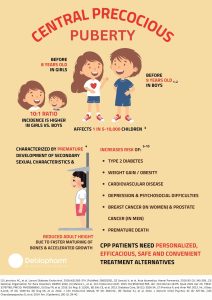
Central Precocious Puberty
Central precocious puberty is a condition that causes early sexual development in girls and boys. Puberty normally starts between ages 8 and 13 in girls and 9 and 14 in boys. In girls with central precocious puberty, signs of pubertal development are visible before age 8 and in boys with this disorder they begin before age 9.
Signs of puberty include development of pubic and underarm hair, a rapid increase in height (commonly referred to as a “growth spurt”), acne and underarm odor. Girls also develop breasts and begin their menstrual periods. Boys have growth of the penis and testes and deepening of the voice.
Because of the early growth spurt, children with central precocious puberty may be taller than their peers; however, they may stop growing abnormally early. Without proper treatment, some affected individuals are shorter in adulthood compared with other members of their family. Developing ahead of their peers can be emotionally difficult for affected individuals and may lead to psychological and behavioral problems.

Clinical trials
A ‘clinical trial’ is a research study in which people agree to test a potential new treatment to prevent or improve a disease or medical condition. A clinical trial also looks at how participants react to the potential new treatment and if any unwanted effects occur. This helps to determine if the new investigational treatment works, is safe, and is better than those that are already available. Many clinical trials also compare existing treatments or test new ways to use or combine existing treatments.
All new drugs must be tested in clinical trials before they can be prescribed to patients. Without children and people taking part in these research studies, we would have no new drugs to help others with their condition. Diverse groups of participants are included in clinical trials because drugs may affect people differently based on their age, sex, gender and ethnicity.
Clinical trial of triptorelin in children with precocious puberty
Debiopharm International has conducted a Phase III trial of triptorelin Definition Triptorelin, the active substance of Decapeptyl®/Trelstar®/Pamorelin®, is a GnRH agonist analogue. An agonist is a chemical that binds to a receptor of a cell and triggers a response by that cell. More info: http://bit.ly/2vO2Px7 22.5 mg 6-month formulation in children with precocious puberty, a hormonal Definition a hormone is a substance produced by a gland that regulates other parts of the body disorder causing early pubertal changes Definition development of pubic hair and breasts and onset of menstrual periods in girls, and increased growth of testicles and penis in boys and accelerates growth speed and maturation of the bones. The purpose of this trial was to show that triptorelin Definition Triptorelin, the active substance of Decapeptyl®/Trelstar®/Pamorelin®, is a GnRH agonist analogue. An agonist is a chemical that binds to a receptor of a cell and triggers a response by that cell. More info: http://bit.ly/2vO2Px7 works and is safe in children with precocious puberty when it is injected by the intramuscular route (i.e. in the muscle) every six months (triptorelin Definition Triptorelin, the active substance of Decapeptyl®/Trelstar®/Pamorelin®, is a GnRH agonist analogue. An agonist is a chemical that binds to a receptor of a cell and triggers a response by that cell. More info: http://bit.ly/2vO2Px7 6-month formulation). The treatment in this study lasted 1 year, each child being injected twice with the triptorelin Definition Triptorelin, the active substance of Decapeptyl®/Trelstar®/Pamorelin®, is a GnRH agonist analogue. An agonist is a chemical that binds to a receptor of a cell and triggers a response by that cell. More info: http://bit.ly/2vO2Px7 6-month formulation. This indication has since been registered in Europe and the submission dossier registration is currently being examined in the US.
Triptorelin has been used for the treatment of precocious puberty since 1986, especially in Europe. The effect of triptorelin Definition Triptorelin, the active substance of Decapeptyl®/Trelstar®/Pamorelin®, is a GnRH agonist analogue. An agonist is a chemical that binds to a receptor of a cell and triggers a response by that cell. More info: http://bit.ly/2vO2Px7 is to reduce the quantity of the hormones in the body responsible for the early pubertal changes described above. In the beginning, triptorelin Definition Triptorelin, the active substance of Decapeptyl®/Trelstar®/Pamorelin®, is a GnRH agonist analogue. An agonist is a chemical that binds to a receptor of a cell and triggers a response by that cell. More info: http://bit.ly/2vO2Px7 was given as injections administered every month or every three months. The triptorelin Definition Triptorelin, the active substance of Decapeptyl®/Trelstar®/Pamorelin®, is a GnRH agonist analogue. An agonist is a chemical that binds to a receptor of a cell and triggers a response by that cell. More info: http://bit.ly/2vO2Px7 preparation that was administered in this recent trial is similar to the triptorelin Definition Triptorelin, the active substance of Decapeptyl®/Trelstar®/Pamorelin®, is a GnRH agonist analogue. An agonist is a chemical that binds to a receptor of a cell and triggers a response by that cell. More info: http://bit.ly/2vO2Px7 injected every month or every three months except that it can be injected every six months. These preparations are all sustained-release formulations produced in such a way that once the drug has been injected, the drug is released in the body continuously over the indicated period.
-
Phases
When a potential new medication is being developed, it is first tested in a laboratory setting. If the results are positive, the drug may enter a clinical trial program. This means that it will be tested in humans in several ‘phases’ of study.
Phase I = Safety evaluation. The very first administration in humans, typically carried out in a small group of healthy volunteers to assess if the drug is safe.
Phase II = Efficacy evaluation. The first trials in patients with the intended disease to check if the drug works efficiently and if there are any unwanted side effects.
Phase III = Confirming findings. Trials in large numbers of patients that generally compare the drug to the best treatments available._Phases
- P
- Ⅰ
- Ⅱ
- Ⅲ
- M
Please share any related associations that may be useful